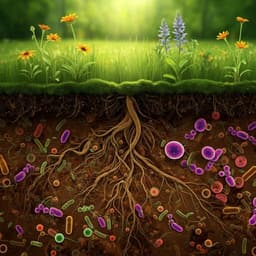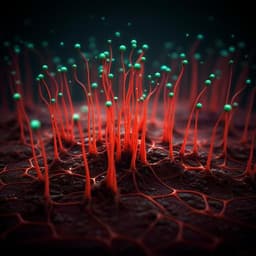
Agriculture
Contrasting response of soil microbiomes to long-term fertilization in various highland cropping systems
W. Kong, L. Qiu, et al.
This fascinating study by Weibo Kong, Liping Qiu, Satoshi Ishii, Xiaoxu Jia, Fuyuan Su, Yu Song, Mingde Hao, Mingan Shao, and Xiaorong Wei delves into how 36 years of fertilization with phosphorus, nitrogen, and manure reshapes soil bacterial communities and impacts crop productivity across various highland cropping systems in China. Discover the surprising interactions between fertilization and soil health that could revolutionize agricultural practices!
~3 min • Beginner • English
Introduction
The study addresses how long-term fertilization shapes soil microbiomes, their functionality, and links to crop productivity across contrasting cropping systems under the same soil and climate. Although microbial contributions to nutrient cycling, organic matter decomposition, and plant health are recognized, the role of soil microbiota in determining ecosystem productivity and how fertilization modulates these communities remain unclear and often inconsistent across studies due to confounding effects of soil type, climate, and vegetation. Including legumes can alter nutrient dynamics via symbiotic N fixation and root exudates, potentially changing microbial responses to fertilization. The authors hypothesize that fertilization induces contrasting effects on soil microbiomes and their associations with soil properties between legume and non-legume systems, given nitrogen’s central role in regulating microbiomes. They ask: (1) How does long-term fertilization affect soil microbiomes in legume vs. non-legume systems? (2) Do links between soil nutrients and microbial communities differ between legume and non-legume systems? (3) How do soil nutrients and microbial communities relate to productivity in highland agroecosystems?
Literature Review
Prior work shows combined chemical and organic fertilization can enhance yields and soil health via changes in microbial composition and activity, such as increased beneficial taxa and enzymes, but responses of microbial diversity and composition to fertilization are inconsistent: diversity can increase with added nutrients, decrease due to overfertilization or antibiotic loading from manures, or show no significant change. Soil type, climate, and vegetation strongly modulate microbial responses to fertilization, leading to contrasting outcomes across Mollisols, Ultisols, and Inceptisols and along climatic gradients. Vegetation, including legumes, influences microbial communities via root exudates, nutrient uptake, litter quality, and enzyme activities. Continuous monocropping can degrade soil quality and destabilize microbial communities, whereas rotations increase substrate diversity and may enhance plant growth-promoting microbes. Legume systems typically have higher soil N via symbiotic fixation, potentially altering fertilization responses relative to non-legume systems, underscoring the need for within-site comparisons across cropping systems.
Methodology
Study site: Long-term fertilization experiment established in 1984 in Changwu County, Shaanxi Province, China (35°12′N, 107°40′E; 1200 m). Warm temperate semi-humid climate; mean annual temperature 9.2 °C; precipitation 578 mm (mostly July–September). Soil: Calcaric Regosol, clay loam.
Experimental design: Three cropping systems: continuous alfalfa (AC), continuous winter wheat (WC), and a grain-legume rotation (GLR; 3-year sequence winter wheat–millet–pea–winter wheat). Fertilization treatments: CK (unfertilized), P (26 kg P ha−1 yr−1 as calcium superphosphate), NP (P plus 120 kg N ha−1 yr−1 as urea), and NPM (NP plus 75 Mg ha−1 yr−1 composted cattle manure; dry basis). AC received CK, P, and NPM; WC and GLR received CK, P, NP, NPM. Plots 10.3 m × 6.5 m; randomized with three replicates. Manure (soil:manure 1:2.3 mix) contained SOC 17.68 g kg−1, TN 1.97 g kg−1, TP 0.97 g kg−1, available N 91 mg kg−1, available P 115 mg kg−1; manure C input ~1.3 Mg C ha−1 yr−1; NPM delivered 98.8 kg P, 267.8 kg N, and 126.8 kg available N ha−1 yr−1. Management followed local practices; surface application before sowing and tillage to ~20 cm; crop-specific sowing and harvest schedules as described.
Sampling: July 2020, two subplots per plot; five 0–20 cm soil cores combined per subplot; 66 composite samples. Soils sieved (2 mm) and partitioned for: moisture and mineral N (4 °C), physicochemical properties (air-dried), enzyme activities (−20 °C), and microbial analyses (−80 °C).
Soil analyses: Moisture by oven-dry gravimetry; NH4+ and NO3− extracted in 2 M KCl and analyzed on Auto-Analyzer-AA3; SOC by dichromate oxidation; TN by Kjeldahl; available P by Olsen; pH in 1:2.5 soil:water.
Microbial activity: Enzyme assays (fluorometric microplate) for C acquisition (β-1,4-glucosidase, β-D-cellobiohydrolase, β-xylosidase), N acquisition (β-1,4-N-acetylglucosaminidase, L-leucine aminopeptidase), and P acquisition (alkaline phosphatase). Summed as EEC, EEN, EEP; potential soil respiration via 30-day aerobic incubation at 25 °C; cumulative CO2-C quantified by NaOH traps and titration; z-scores averaged to characterize microbial activity.
DNA and sequencing: DNA from 0.5 g soil (FastDNA Spin kit); 16S rRNA gene V3–V4 amplified with 341F/806R; PCR with 30 cycles; amplicons purified, indexed, and sequenced (Illumina NovaSeq, 2×250 bp). Bioinformatics in QIIME 2 (v2020.11) with DADA2; forward reads truncated at 220 bp; taxonomy via SILVA 138 Naïve Bayes; removed singletons, chloroplasts, mitochondria; 4,182,288 high-quality sequences (38,463–87,256 per sample; median 64,092); rarefied to 38,463 reads per sample.
Statistics: Linear mixed-effects models (cropping system and fertilization fixed; plot random) for soil properties, alpha diversity, microbial activity, and productivity; transformations as needed; Wilcoxon rank-sum tests for pairwise differences (P < 0.05). Community composition assessed by Bray-Curtis PCoA and PERMANOVA; Venn diagrams for shared/unique ASVs. dbRDA for linking communities to soil properties. Differential abundance with DESeq2 (Wald test, BH FDR < 0.05) to identify fertilization-responsive ASVs per system and system-responsive ASVs per fertilization. Core taxa defined as ASVs present in all samples (100% prevalence). Co-occurrence networks by SparCC using taxa with mean relative abundance >0.01%; edges r > 0.65, FDR < 0.05; compared to 1000 Erdős–Rényi random networks; node-level metrics and robustness (normalized natural connectivity). Mantel tests for matrices of soil properties, microbial activity, productivity, and community structures (all/core/responsive). Random forest and variance partitioning to evaluate importance of soil properties and community components for microbial activity and productivity; tuneRF to optimize mtry. Piecewise SEMs per system to test direct/indirect effects of key soil nutrients (from RF) and core/responsive communities on microbial activity and productivity; mixed models with plot random effects; microbial activity log-transformed; model fit via Shipley’s d-separation; report standardized paths, Fisher’s C, AIC/BIC, and R2.
Key Findings
- Soil and productivity: Cropping system significantly influenced most soil properties and microbial activity. AC had highest SOC, TN, C/N, NH4+, NO3−, enzyme activities (EEC, EEN, EEP), and composite microbial activity, but lowest available P (OP). Wheat yield was higher in GLR than WC. P treatment increased OP and boosted productivity in AC and GLR but reduced it in WC. NPM markedly increased SOC, TN, NO3−, EEP, microbial activity, and productivity across systems, with stronger effects in WC and GLR than AC. NP (in WC and GLR only) increased available N and P and microbial activity.
- Alpha diversity and richness: Under CK and NPM, AC and WC had higher observed ASVs, Shannon, and Chao1 than GLR. Fertilization effects were system-dependent: diversity increased in AC, unchanged in WC, and decreased in GLR; NPM had the strongest effects.
- Community composition: 38 bacterial phyla detected; Proteobacteria (25.9%), Acidobacteriota (21.5%), Actinobacteriota (13.9%), Gemmatimonadota (13.6%), and Bacteroidota (4.4%) dominated (>79% of reads). PERMANOVA showed significant effects of cropping system (R2 = 0.191, P < 0.001), fertilization (R2 = 0.106, P < 0.001), and interaction (R2 = 0.089, P < 0.001). Within systems, fertilization explained R2 = 0.238–0.272 (P < 0.001).
- Core taxa vs. responsive taxa: 24 core taxa were stable across treatments. DESeq2 identified more fertilization-responsive ASVs in NPM (166–263) than P or NP (4–129), with contrasting enriched vs. depleted patterns by system. AC: P enriched 20 and depleted 19; NPM enriched 106 and depleted 60. WC: P enriched 1/depleted 3; NP enriched 9/depleted 13; NPM enriched 120/depleted 98. GLR: P enriched 10/depleted 32; NP enriched 31/depleted 98; NPM enriched 68/depleted 195. Responsive taxa were mainly Proteobacteria, Acidobacteriota, Actinobacteriota, Gemmatimonadota, Firmicutes, varying by system.
- Networks: Co-occurrence networks were scale-free. AC had more complex, connected, and robust networks than GLR and WC; fertilization (especially NPM) increased AC network complexity but had limited effect in WC and GLR. Core and responsive nodes had higher degree and betweenness centrality than others; GLR networks had more connections involving core taxa; the core network was more complex and robust in GLR than WC and AC.
- Environmental drivers: dbRDA and random forest indicated bacterial communities were most influenced by OP and N/P in AC, but by SOC, TN, and NO3− in WC and GLR. Mantel and RF analyses showed soil properties (SOC, TN, NO3−, OP), and the composition and abundance of core and responsive communities significantly predicted microbial activity and productivity.
- Functional linkages (SEM): In AC, communities were driven by OP; microbial activity was directly linked to SOC; productivity was directly affected by NO3− and indirectly by OP via responsive communities. In WC and GLR, communities were driven by SOC and NO3−; microbial activity was directly (GLR) or indirectly (WC) related to SOC via communities; productivity was indirectly affected by SOC/NO3− through changes in communities.
- Overall, manure-inclusive fertilization enlarged microbiome differences among cropping systems, and productivity correlated with fertilization-responsive taxa in all systems.
Discussion
This study demonstrates that long-term fertilization elicits contrasting microbiome responses depending on cropping system identity, particularly legume versus non-legume systems. In the legume-based AC system, manure-inclusive fertilization enhanced bacterial alpha diversity, network complexity, and robustness, likely due to greater niche diversity and nutrient availability from symbiotic N fixation and combined inputs. In contrast, GLR exhibited reduced diversity and a higher number of fertilization-depleted ASVs, implying lower microbiome resistance under fertilization in this rotation system, potentially due to frequent disturbances and pea-associated legacy effects. WC showed stable diversity but significant compositional shifts, indicating community reassembly without a net change in diversity.
Environmental controls differed by system: P availability (OP) and N/P ratio governed community variation in AC, consistent with greater P demand and lower OP under legumes, whereas SOC, TN, and NO3− were dominant drivers in WC and GLR where N was more limiting. Co-occurrence analyses highlight the structural importance of core and responsive taxa in maintaining network connectivity and robustness, with fertilization amplifying these taxa’s roles, particularly in AC. Importantly, fertilization-responsive taxa that increased with NPM were positively associated with microbial activity and productivity across systems, suggesting they mediate the pathway from nutrient enrichment to ecosystem functioning and yield.
These findings answer the research questions by showing: (1) Fertilization increases diversity in AC, decreases it in GLR, and leaves it unchanged in WC, with manure driving stronger, system-specific shifts in composition and networks. (2) Nutrient–microbiome linkages differ: OP dominates in AC, while SOC and N forms dominate in WC and GLR. (3) Productivity is linked indirectly to nutrient effects via changes in responsive microbial taxa across all systems, underscoring the functional importance of these taxa for agroecosystem performance.
Conclusion
The study provides a long-term, within-site comparison showing that fertilization effects on soil microbiomes are contingent on cropping system type. Manure-inclusive fertilization increased bacterial diversity and network complexity in the alfalfa (legume) system, decreased diversity in the grain-legume rotation, and did not alter diversity in continuous wheat, while significantly reshaping community composition in all systems. Microbial community variation was governed by available P in the legume system and by SOC and mineral N in non-legume systems. Crop productivity correlated with fertilization-responsive taxa, indicating these taxa mediate fertilization benefits to yields.
Main contributions include disentangling legume versus non-legume responses under identical soil and climate, identifying system-specific nutrient controls on microbiomes, and demonstrating the functional relevance of responsive taxa to activity and productivity. Future research should employ manipulative experiments to establish causal relationships, target management of responsive taxa, and refine fertilization strategies that balance nutrient pools, maintain microbial diversity and network stability, and sustain productivity, particularly in rotation systems with legumes where diversity losses were observed under high-input fertilization.
Limitations
Many analyses rely on correlations (dbRDA, network analysis, Mantel tests, a priori SEM), limiting causal inference. The GLR sampling occurred two years after the pea phase, potentially underrepresenting immediate legume effects. Network inferences reflect co-occurrence rather than confirmed interactions. Amplicon-based relative abundances and rarefaction may bias quantitative interpretations. Broader functional assays (metagenomics, metatranscriptomics) were not conducted.
Related Publications
Explore these studies to deepen your understanding of the subject.







